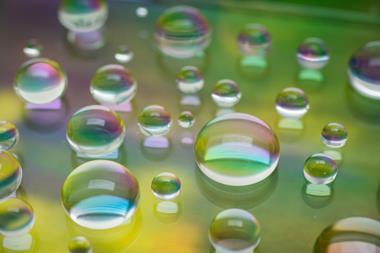Ferrofluid-based surfaces show multiple tuneable properties
Infusing a porous solid with a magnetic liquid – or ferrofluid – produces surfaces whose texture can be altered using a magnetic field, making it easy to vary properties such as friction or stickiness.1 The new materials could be used for microfluidic devices, fouling-release systems or pharmaceutical applications.
There is great interest in developing materials with functions such as switchable adhesion or the ability to self-heal. Since the texture – or surface topography – of an object determines how it interacts with the environment, surfaces with tuneable topography are an excellent way to achieve this. The approach has been explored using hybrid composites, liquid crystals, shape-memory polymers, responsive gels and ferrofluids before,2 but all the designs reported so far exhibit a limited range of topographical changes.
Now, an international team led by Joanna Aizenberg at Harvard University, US, has created a new type of dynamic surface that can be reconfigured at multiple length scales, leading to a variety of switchable properties. ‘Our key contribution is the realisation of all those separate applications by bringing seemingly disparate properties and functions under one conceptual framework of dynamic multiscale topography,’ says Wendong Wang from the Max Planck Institute for Intelligent Systems in Germany, one of the researchers involved.
To prepare their new ferrofluid-containing liquid-infused porous surfaces (FLIPS), Wang and colleagues took different microstructured substrates including arrays fabricated by soft lithography and commercial membranes and infiltrated them with fluorocarbon or silicon oil based ferrofluids. They then used permanent magnets or electromagnets to induce changes on the surfaces. ‘As long as no magnetic fields are applied, the ferrofluid is retained by the pores and forms a smooth film on the surface,’ explains Peter Fratzl of the Max Planck Institute for Colloids and Interfaces, Germany, who was not involved in the research. But this changes when a magnetic field is applied, he says. ‘The ferrofluid will then start to flow in the pores and take on complex shapes on the surface that result as a compromise between magnetic attraction and capillary forces.’
Hadi Ghasemi of the University of Houston, US, notes that the functionality of FLIPS is somewhat similar to that of the magnetic slippery surfaces (MAGSS) developed by his group in 20162 but recognises that FLIPS can be tuned for different purposes including microparticle manipulation, controlled mixing of droplets, switchable adhesion and biofilm removal. ‘These surfaces promise a facile approach for moving liquids in small channels in microfluidic devices,’ he says. ‘Or they could be used as a route for cleaning clogged tubes.’
Ghasemi points out that the long-term durability and functionality of FLIPS must still be studied and Fratzl agrees that stability is an important issue. ‘A challenge that will arise with many practical applications is how to manage the absorption of (even small) dust particles that are omnipresent in many environments. If they start to clog the porosity of the support material, many of the interesting behaviours may be lost,’ he says.
References
- W Wang et al, Nature, 2018, DOI: 10.1038/s41586-018-0250-8
- P Irajizad et al, Nat. Commun., 2016, 7, 13395 (DOI: 10.1038/ncomms13395)












No comments yet